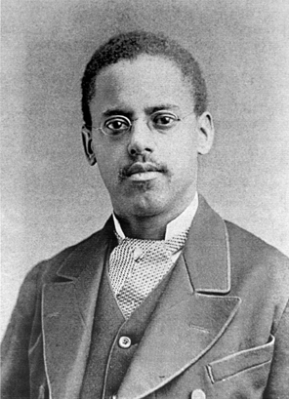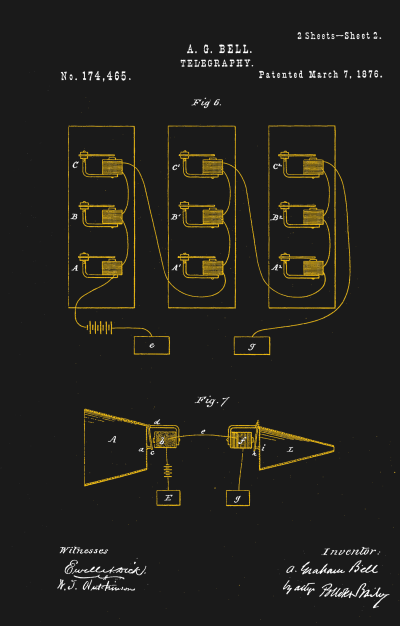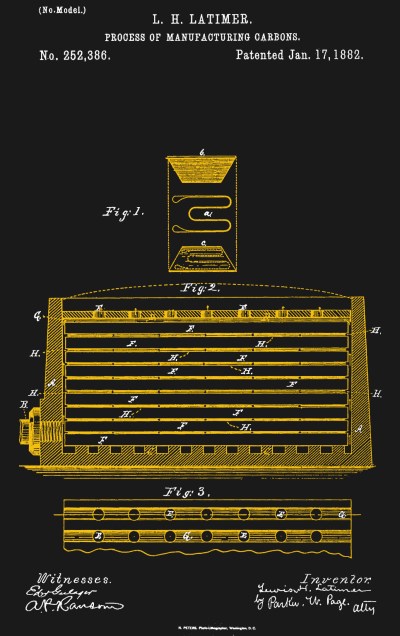Lewis Latimer Drafted the Future of Electric Light
These days, we have LED light bulbs that will last a decade. But it wasn’t so long ago that incandescent lamps were all we had, and they burned out after several months. Thomas Edison’s early light bulbs used bamboo filaments that burned out very quickly. An inventor and draftsman named Lewis Latimer improved Edison’s filament by encasing it in cardboard, earning himself a patent the process.
Lewis had a hard early life, but he succeeded in spite of the odds and his lack of formal education. He was a respected draftsman who earned several patents and worked directly with Alexander Graham Bell and Thomas Edison. Although Lewis didn’t invent the light bulb, he definitely made it better and longer-lasting.

Born Free
Lewis Howard Latimer was born September 4th, 1848 in Chelsea, Massachusetts, near Boston. He was the youngest of four children. Lewis’ parents, George and Rebecca, had been slaves in Virginia, but Lewis was born in free territory.
Eight years before Lewis was born, his parents escaped to the north on a steamer, but George was captured in 1842 when someone who knew his former owner spotted him on the street. His plight caught the attention of abolitionist leaders who raised money from the citizens of Boston to purchase George’s freedom. By this time, Rebecca was pregnant with George junior.
In Chelsea, George worked as a wallpaper-hanger and also owned a barbershop. Lewis helped his father with both until George disappeared when Lewis was 10 years old. The Emancipation Proclamation was still a few years away, and it is thought that he was tired of worrying about being recaptured and went underground.
At 13, Lewis got a job as an office boy in an attorney’s office. He lied about his age and joined the Union Navy at age 15, but was honorably discharged about a year later. He helped his mother clean houses for a while, and then found out that the patent office of Crosby & Gregory was looking for a boy with a taste for drawing. Lewis had always liked drawing and jumped at the opportunity.

Drafting the Future
At Crosby & Gregory, Lewis provided a constant shadow for the company’s draftsman whenever he could spare a second between office duties. He soon bought a set of secondhand tools and books, and practiced technical drawing in his spare time. Eventually, the draftsman let him do some sample drafting. They were impressed with Lewis’ skills, and when the draftsman resigned, Lewis got the job.
Drafting patents requires that the artist and the inventor work closely together. Because of this, Lewis learned about a lot of things and was well-versed in the the technical and legal aspects of patents by the 1870s. Lewis applied for his own patent for the first time in 1874 — an improvement for water closets in railroad cars. It was deemed too insignificant for a patent.
In the mid-1870s, his firm was working on patents for Alexander Graham Bell’s telephone, and Lewis Latimer was drafting all the technical drawings. In keeping with the lore about Bell’s work and sleep habits, legend has it that Lewis had to wait until after 9PM each night for Bell to be available to give him his instructions.
Lewis left Crosby & Gregory in 1878 because of management changes. During this time he worked a few jobs slinging wallpaper paste like his father before him and relocated with his wife Mary Wilson (whom he wed in 1873) and two daughters to Bridgeport, Connecticut where his sister lived. There he would eventually land a drafting job at Fallandsbee Machine Shop.
The Draw of Electric Light
After Thomas Edison received a patent for the light bulb in 1879, electric lighting began to quickly taking over gas lighting. Historians suggest that Lewis had become enamored by electric light and believed it was the future. It was certainly in his future.
One day, Hiram Maxim, owner of the United States Electric Lighting Company strolled into the machine shop. He saw Lewis sitting there drafting and was intrigued. Maxim asked him a bunch of questions and by the end of the conversation, he’d hired Lewis as his draftsman and general assistant.

Lewis started at the two-year-old company in 1880. Maxim was trying to make light bulbs, the hot new gadget of the times. He and his partner William Sawyer had incandescent lamp patents, and theirs was only the second to market after Edison’s.
Maxim’s process for treating filaments included a hydrocarbon vapor that equalized and standardized resistance. It also made them burn longer than the Edison filaments, which were made of bamboo. Lewis perfected a way to produce these filaments without breaking, as they were prone to do. He suggested using a material with the same rates of expansion and contraction as the filament blanks. Lewis received a patent for this method in 1882.
Although U.S. Electric’s lamps had a longer-lasting filament, they didn’t beat Edison because they didn’t have the scientific method down, doing mostly guesswork instead. While US Electrical focused on a quality lamp, Edison wanted complete vertical integration of the electrical world from the filament to the dynamo.
Like many 1880s startups, U.S.Electric was one among many small companies vying for light bulb market share. Lewis was terribly important to the operation and likely the only draftsman that Maxim had and his value extended far beyond the drawing table. He had the great responsibility of overseeing lighting installations, which requires a lot of knowledge. In 1881, Lewis became superintendent of the incandescent lamp department, overseeing 40 workers.
Around this time, U.S. Electric merged with Weston Electric. Lewis was sent to England to oversee a large lighting installation. Although the workers didn’t care to take orders from a black man at first, he eventually won them over. When his contract was up in England, he and Mary moved back to the States, but there was no job to come back to. He moved from company to company for a while and wound up at Olmstead Electrical in Brooklyn as draftsman and manager of lamp fabrication. Lewis convinced them to manufacture his lamp, but it never received a patent and wasn’t commercially successful.

Edison’s Pioneers
In 1884, Lewis was hired by the Edison company to be their chief draftsman and expert witness as to the facts as they related to the early stages of the electric light business. In other words, he helped Edison prosecute patent infringers. The only suit that went anywhere was the one against Lewis’ old company, U.S. Electrical, which Edison won. In 1889, Lewis joined the Edison legal department, though he still had drafting duties.
General Electric was created when Thomson-Houston and Edison Electrical merged on April 15, 1892. Westinghouse remained heir biggest competitor. By 1896, there were 300+ lawsuits pending between the GE and Westinghouse. They finally reached an agreement in 1896 and pooled the bulk of their patents, with GE retaining their own incandescent lamp patents.
Lewis was asked to join the Edison Pioneers, a group of twenty-eight men who had been integral to the development of the light bulb up to and including 1885. He was bestowed this honor despite never working in Edison’s laboratory itself, and was the only African-American member. In 1890, Lewis published Incandescent Electric Lighting, a practical description of the Edison system.
Lewis died December 11, 1928 after a lengthy illness. He was 80 years old.
from Blog – Hackaday https://ift.tt/2ThZteJ
Comments
Post a Comment